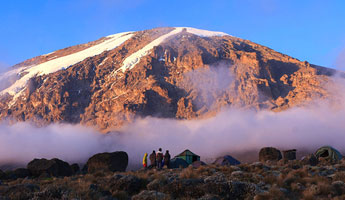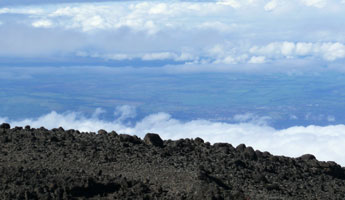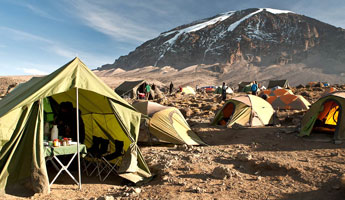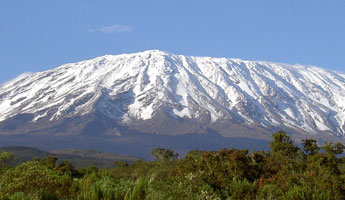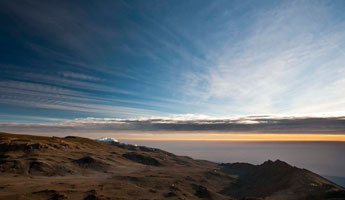CLIMBING MT. KILIMANJARO
"An Adventure of a Lifetime!"
Mount Kilimanjaro. So much more than just being the highest peak in the entire African continent AND the tallest free-standing mountain in the world.
For many, it represents the ultimate once-in-a-lifetime personal challenge - an arduous but highly rewarding 6 to 8 day trek up to Uhuru Point (the actual summit) or to Gillman's Point (on the lip of the crater).
The famous snow-covered peak of Kilimanjaro towers an impressive 5,895 metres (19,336 feet) above the African plains below. It is situated within the Kilimanjaro National Park, a UNESCO World Heritage Site, and is about a 130 km drive from Arusha.
The slopes are covered with a variety of vegetation, starting with dense tropical forests at the base, which are inhabited by elephant, leopard, buffalo, the endangered Abbot’s duiker, and other small antelope and primates.
Further up, the vegetation changes to moorland, covered with heathers. When you reach 4,000 metres, the alpine desert landscape begins, whose extreme temperature fluctuations means that very little in terms of plant and wildlife can survive here, with the exception of a few hardy mosses and lichens.
And finally, the desert turns into a winter scene of snow and ice - and before you know it, you are at the summit, looking out over the world.
Lying only 3 degrees south of the Equator and at an altitude of 5895 meters above sea level. "As wide as all the world, great, high and unbelievable white in the sun, was square top of Mt. Kilimanjaro", so wrote Ernest Hemingway.
Mt. Kilimanjaro is the highest mountain in Africa, the highest free standing mountain in the world, and one of the largest volcanoes ever to burst through the earth’s crusts. The base of this immense mountain measure 50 x 80 km and the outstanding features are the three major volcanic centers, Shira in the west (4260 m), Mawenzi in the East (5260 m) and the snow capped Kibo is the middle (5895 m).
Apart from its dramatic geological features and the beautiful montane vegetation, Mount Kilimanjaro is also notable for its bird life, which is plentiful in the rich forest zone. There is also a wide array of butterflies, moths and other insects. The mountain can be climbed anytime of the year although it is often wet in the forest during the rainy season in April and May. The best period is from August to November.
Climbing The Mountain
Since the summit of Kilimanjaro was first reached by the German geographer Hans Meyer and Austrian mountain climber Ludwig Purtscheller on 5th October 1889, literally thousands of people have succeeded in, or have attempted. the very same feat. It is estimated that today, a staggering 25,000 people a year set off on the journey.
There are 5 main routes up to the summit: Marangu, Machame, Rongai, Lemosho and Umbwe. You can pick the route that you think is best suited to you, and also the one that will give you exactly want you personally want to get out of your trek. Your accommodation will be tents, which are carried up by porters, but if you don't fancy sleeping under canvas, then you should definitely choose the Marangu Route, as this is the only route where you sleep in dormitory style huts.
All climbs have to be pre-booked, so you cannot just turn up on a whim and hope to start your climb that day or the next.
There are many excellent operators that you can pre-book with, who offer either pre-arranged treks on given dates with groups up to about 8 - 12 people (for safety reasons), or you can arrange a private trek with your own guide (minimum 2 people).
Obviously, it goes without saying that a reasonable level of fitness is required to climb Kilimanjaro, and most operators request that you consult your doctor to be given the 'all-clear' to climb prior to booking your trip.
The best months to climb Kilimanjaro are from January to mid-March and June to October, as these are the dry seasons.
Skills and Routes
Climbing Mt. Kilimanjaro does not require professional climbing skills. It is, however, a strenuous climb and physical fitness is extremely important. There are several different routes up the mountain with varying degrees of difficulty. Before you decide on climb, you should consult with your physician and choose the best suited to your physical abilities. One good ‘’ measuring stick’ to determine your ability to reach the summit is whether you are able to jog slowly for an hour or more without experiencing shortness of breath.
Guides, Porters & Accommodation
All of our climbs are accompanied by experienced mountain guides and porters. Accommodations differ depending on the route and include both high- altitude tents and dormitory- style mountain lodges. The facilities are clean but Spartan, so you should be prepare to ‘”rough it” as you make your ascent. One of your porters “double” as cook and will prepare three meals a day for you while you climb.
Equipment
You can rent equipment (such as sleeping bags, walking sticks, etc) locally, although many climbers prefer to bring their own sleeping bag. When you book, you’ll receive a detailed list of suggested equipment and clothing. Dressing in layers helps you adjust to the varying temperatures during the day and at different altitudes.
One Stop Kilimanjaro Booking Service
Simba Safaris - Climbing Kilimanjaro, has more than 40 years of experience in leading clients to the summit. Our experienced guides have a proud success rate of 96%+. Our professional tour consultants have all made successful summit attempts and are therefore in a position to provide you with an in depth knowledge on a planned summit attempt. We provide unique and tailor-made itineraries to suite your individual requirements and preferences, including all your accommodation bookings, meet and assist at the airport, airport transfers, as well as many exciting Safari extensions to All National Parks and Game reserve in the country and Kenya and the magical island of Zanzibar.
Kilimanjaro is an awesome spectacle, and climbing it is achievable by anyone who is determined and reasonably fit. There are several routes to the summit, of which we recommend four. The Marangu (7 Days) and Rongai are easiest, while Machame (8 Days) and Shira provide more difficult ascents.


